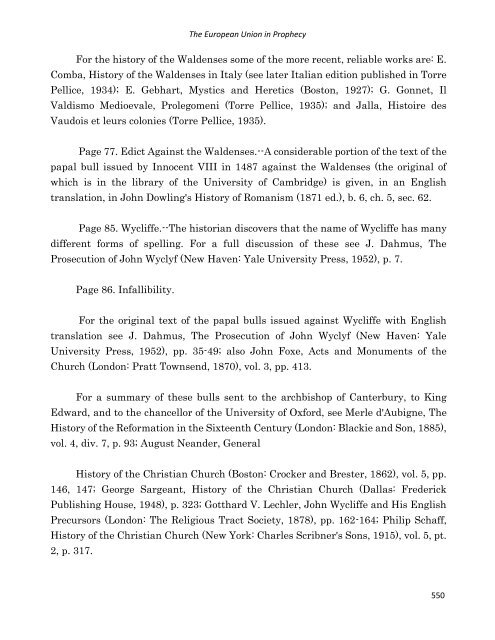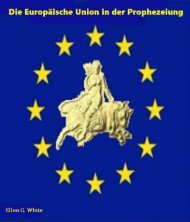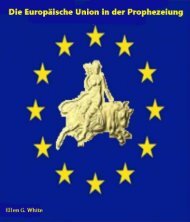- Page 2 and 3:
Ellen G. White
- Page 4 and 5:
The European Union in Prophecy Tabl
- Page 6 and 7:
The European Union in Prophecy 1. W
- Page 8 and 9:
The European Union in Prophecy had
- Page 10 and 11:
The European Union in Prophecy dest
- Page 12 and 13:
The European Union in Prophecy taug
- Page 14 and 15:
The European Union in Prophecy reve
- Page 16 and 17:
The European Union in Prophecy wond
- Page 18 and 19:
The European Union in Prophecy thei
- Page 20 and 21:
The European Union in Prophecy of t
- Page 22 and 23:
The European Union in Prophecy obey
- Page 24 and 25:
The European Union in Prophecy ente
- Page 26 and 27:
The European Union in Prophecy they
- Page 28 and 29:
The European Union in Prophecy fals
- Page 30 and 31:
The European Union in Prophecy dest
- Page 32 and 33:
The European Union in Prophecy ackn
- Page 34 and 35:
The European Union in Prophecy Cons
- Page 36 and 37:
The European Union in Prophecy the
- Page 38 and 39:
The European Union in Prophecy come
- Page 40 and 41:
The European Union in Prophecy The
- Page 42 and 43:
The European Union in Prophecy When
- Page 44 and 45:
The European Union in Prophecy Amon
- Page 46 and 47:
The European Union in Prophecy to b
- Page 48 and 49:
The European Union in Prophecy Fran
- Page 50 and 51:
The European Union in Prophecy thei
- Page 52 and 53:
The European Union in Prophecy just
- Page 54 and 55:
The European Union in Prophecy The
- Page 56 and 57:
The European Union in Prophecy and
- Page 58 and 59:
The European Union in Prophecy thei
- Page 60 and 61:
The European Union in Prophecy Lutt
- Page 62 and 63:
The European Union in Prophecy firm
- Page 64 and 65:
The European Union in Prophecy "Wit
- Page 66 and 67:
The European Union in Prophecy So b
- Page 68 and 69:
The European Union in Prophecy The
- Page 70 and 71:
The European Union in Prophecy as a
- Page 72 and 73:
The European Union in Prophecy who
- Page 74 and 75:
The European Union in Prophecy the
- Page 76 and 77:
The European Union in Prophecy wear
- Page 78 and 79:
The European Union in Prophecy grea
- Page 80 and 81:
The European Union in Prophecy enem
- Page 82 and 83:
The European Union in Prophecy In s
- Page 84 and 85:
The European Union in Prophecy of S
- Page 86 and 87:
The European Union in Prophecy A la
- Page 88 and 89:
The European Union in Prophecy 7. A
- Page 90 and 91:
The European Union in Prophecy read
- Page 92 and 93:
The European Union in Prophecy wher
- Page 94 and 95:
The European Union in Prophecy had
- Page 96 and 97:
The European Union in Prophecy trus
- Page 98 and 99:
The European Union in Prophecy In t
- Page 100 and 101:
The European Union in Prophecy body
- Page 102 and 103:
The European Union in Prophecy With
- Page 104 and 105:
The European Union in Prophecy the
- Page 106 and 107:
The European Union in Prophecy men,
- Page 108 and 109:
The European Union in Prophecy 8. T
- Page 110 and 111:
The European Union in Prophecy appe
- Page 112 and 113:
The European Union in Prophecy A co
- Page 114 and 115:
The European Union in Prophecy as i
- Page 116 and 117:
The European Union in Prophecy trib
- Page 118 and 119:
The European Union in Prophecy With
- Page 120 and 121:
The European Union in Prophecy reas
- Page 122 and 123:
The European Union in Prophecy sacr
- Page 124 and 125:
The European Union in Prophecy Fred
- Page 126 and 127:
The European Union in Prophecy in i
- Page 128 and 129:
The European Union in Prophecy 9. R
- Page 130 and 131:
The European Union in Prophecy expl
- Page 132 and 133:
The European Union in Prophecy and
- Page 134 and 135:
The European Union in Prophecy hand
- Page 136 and 137:
The European Union in Prophecy The
- Page 138 and 139:
The European Union in Prophecy The
- Page 140 and 141:
The European Union in Prophecy A fe
- Page 142 and 143:
The European Union in Prophecy In a
- Page 144 and 145:
The European Union in Prophecy lear
- Page 146 and 147:
The European Union in Prophecy apos
- Page 148 and 149:
The European Union in Prophecy Refo
- Page 150 and 151:
The European Union in Prophecy notw
- Page 152 and 153:
The European Union in Prophecy Coul
- Page 154 and 155:
The European Union in Prophecy is n
- Page 156 and 157:
The European Union in Prophecy orde
- Page 158 and 159:
The European Union in Prophecy In t
- Page 160 and 161:
The European Union in Prophecy To M
- Page 162 and 163:
The European Union in Prophecy of t
- Page 164 and 165:
The European Union in Prophecy As t
- Page 166 and 167:
The European Union in Prophecy arms
- Page 168 and 169:
The European Union in Prophecy and
- Page 170 and 171:
The European Union in Prophecy an a
- Page 172 and 173:
The European Union in Prophecy The
- Page 174 and 175:
The European Union in Prophecy disa
- Page 176 and 177:
The European Union in Prophecy A so
- Page 178 and 179:
The European Union in Prophecy gosp
- Page 180 and 181:
The European Union in Prophecy crea
- Page 182 and 183:
The European Union in Prophecy Prot
- Page 184 and 185:
The European Union in Prophecy gosp
- Page 186 and 187:
The European Union in Prophecy bloo
- Page 188 and 189:
The European Union in Prophecy pres
- Page 190 and 191:
The European Union in Prophecy 14.
- Page 192 and 193:
The European Union in Prophecy supp
- Page 194 and 195:
The European Union in Prophecy Hami
- Page 196 and 197:
The European Union in Prophecy test
- Page 198 and 199:
The European Union in Prophecy mani
- Page 200 and 201:
The European Union in Prophecy of f
- Page 202 and 203:
The European Union in Prophecy Said
- Page 204 and 205:
The European Union in Prophecy in t
- Page 206 and 207:
The European Union in Prophecy less
- Page 208 and 209:
The European Union in Prophecy the
- Page 210 and 211:
The European Union in Prophecy It h
- Page 212 and 213:
The European Union in Prophecy were
- Page 214 and 215:
The European Union in Prophecy Comm
- Page 216 and 217:
The European Union in Prophecy long
- Page 218 and 219:
The European Union in Prophecy "But
- Page 220 and 221:
The European Union in Prophecy poli
- Page 222 and 223:
The European Union in Prophecy Cath
- Page 224 and 225:
The European Union in Prophecy The
- Page 226 and 227:
The European Union in Prophecy 16.
- Page 228 and 229:
The European Union in Prophecy When
- Page 230 and 231:
The European Union in Prophecy atte
- Page 232 and 233:
The European Union in Prophecy To s
- Page 234 and 235:
The European Union in Prophecy beca
- Page 236 and 237:
The European Union in Prophecy and
- Page 238 and 239:
The European Union in Prophecy cons
- Page 240 and 241:
The European Union in Prophecy bar
- Page 242 and 243:
The European Union in Prophecy "The
- Page 244 and 245:
The European Union in Prophecy prop
- Page 246 and 247:
The European Union in Prophecy not
- Page 248 and 249:
The European Union in Prophecy land
- Page 250 and 251:
The European Union in Prophecy 18.
- Page 252 and 253:
The European Union in Prophecy I ha
- Page 254 and 255:
The European Union in Prophecy 24:3
- Page 256 and 257:
The European Union in Prophecy seri
- Page 258 and 259:
The European Union in Prophecy brou
- Page 260 and 261:
The European Union in Prophecy 1810
- Page 262 and 263:
The European Union in Prophecy "Wit
- Page 264 and 265:
The European Union in Prophecy Refo
- Page 266 and 267:
The European Union in Prophecy acco
- Page 268 and 269:
The European Union in Prophecy Desp
- Page 270 and 271:
The European Union in Prophecy prai
- Page 272 and 273:
The European Union in Prophecy Why,
- Page 274 and 275:
The European Union in Prophecy Yet
- Page 276 and 277:
The European Union in Prophecy they
- Page 278 and 279:
The European Union in Prophecy unde
- Page 280 and 281:
The European Union in Prophecy In e
- Page 282 and 283:
The European Union in Prophecy With
- Page 284 and 285:
The European Union in Prophecy Lord
- Page 286 and 287:
The European Union in Prophecy with
- Page 288 and 289:
The European Union in Prophecy stri
- Page 290 and 291:
The European Union in Prophecy It w
- Page 292 and 293:
The European Union in Prophecy cont
- Page 294 and 295:
The European Union in Prophecy Farm
- Page 296 and 297:
The European Union in Prophecy worl
- Page 298 and 299:
The European Union in Prophecy were
- Page 300 and 301:
The European Union in Prophecy Abou
- Page 302 and 303:
The European Union in Prophecy diss
- Page 304 and 305:
The European Union in Prophecy he s
- Page 306 and 307:
The European Union in Prophecy Besi
- Page 308 and 309:
The European Union in Prophecy a ta
- Page 310 and 311:
The European Union in Prophecy cann
- Page 312 and 313:
The European Union in Prophecy 22.
- Page 314 and 315:
The European Union in Prophecy the
- Page 316 and 317:
The European Union in Prophecy was
- Page 318 and 319:
The European Union in Prophecy That
- Page 320 and 321:
The European Union in Prophecy It c
- Page 322 and 323:
The European Union in Prophecy repr
- Page 324 and 325:
The European Union in Prophecy of J
- Page 326 and 327:
The European Union in Prophecy 23.
- Page 328 and 329:
The European Union in Prophecy mann
- Page 330 and 331:
The European Union in Prophecy The
- Page 332 and 333:
The European Union in Prophecy the
- Page 334 and 335:
The European Union in Prophecy Once
- Page 336 and 337:
The European Union in Prophecy by D
- Page 338 and 339:
The European Union in Prophecy prop
- Page 340 and 341:
The European Union in Prophecy Prie
- Page 342 and 343:
The European Union in Prophecy in w
- Page 344 and 345:
The European Union in Prophecy of C
- Page 346 and 347:
The European Union in Prophecy 25.
- Page 348 and 349:
The European Union in Prophecy Thos
- Page 350 and 351:
The European Union in Prophecy idol
- Page 352 and 353:
The European Union in Prophecy -G.
- Page 354 and 355:
The European Union in Prophecy civi
- Page 356 and 357:
The European Union in Prophecy of G
- Page 358 and 359:
The European Union in Prophecy The
- Page 360 and 361:
The European Union in Prophecy 26.
- Page 362 and 363:
The European Union in Prophecy test
- Page 364 and 365:
The European Union in Prophecy suff
- Page 366 and 367:
The European Union in Prophecy Now
- Page 368 and 369:
The European Union in Prophecy 27.
- Page 370 and 371:
The European Union in Prophecy cons
- Page 372 and 373:
The European Union in Prophecy Many
- Page 374 and 375:
The European Union in Prophecy guil
- Page 376 and 377:
The European Union in Prophecy 12:2
- Page 378 and 379:
The European Union in Prophecy best
- Page 380 and 381:
The European Union in Prophecy wort
- Page 382 and 383:
The European Union in Prophecy 28.
- Page 384 and 385:
The European Union in Prophecy judg
- Page 386 and 387:
The European Union in Prophecy crea
- Page 388 and 389:
The European Union in Prophecy mist
- Page 390 and 391:
The European Union in Prophecy work
- Page 392 and 393:
The European Union in Prophecy pron
- Page 394 and 395:
The European Union in Prophecy that
- Page 396 and 397:
The European Union in Prophecy God
- Page 398 and 399:
The European Union in Prophecy Sata
- Page 400 and 401:
The European Union in Prophecy this
- Page 402 and 403:
The European Union in Prophecy prov
- Page 404 and 405:
The European Union in Prophecy wher
- Page 406 and 407:
The European Union in Prophecy such
- Page 408 and 409:
The European Union in Prophecy 31.
- Page 410 and 411:
The European Union in Prophecy they
- Page 412 and 413:
The European Union in Prophecy Thos
- Page 414 and 415:
The European Union in Prophecy 32.
- Page 416 and 417:
The European Union in Prophecy The
- Page 418 and 419:
The European Union in Prophecy inte
- Page 420 and 421:
The European Union in Prophecy Innu
- Page 422 and 423:
The European Union in Prophecy Ther
- Page 424 and 425:
The European Union in Prophecy 33.
- Page 426 and 427:
The European Union in Prophecy but
- Page 428 and 429:
The European Union in Prophecy thei
- Page 430 and 431:
The European Union in Prophecy And
- Page 432 and 433:
The European Union in Prophecy tran
- Page 434 and 435:
The European Union in Prophecy cons
- Page 436 and 437:
The European Union in Prophecy an i
- Page 438 and 439:
The European Union in Prophecy the
- Page 440 and 441:
The European Union in Prophecy 34.
- Page 442 and 443:
The European Union in Prophecy heav
- Page 444 and 445:
The European Union in Prophecy thei
- Page 446 and 447:
The European Union in Prophecy the
- Page 448 and 449:
The European Union in Prophecy They
- Page 450 and 451:
The European Union in Prophecy "The
- Page 452 and 453:
The European Union in Prophecy Bril
- Page 454 and 455:
The European Union in Prophecy of t
- Page 456 and 457:
The European Union in Prophecy all
- Page 458 and 459:
The European Union in Prophecy and
- Page 460 and 461:
The European Union in Prophecy nint
- Page 462 and 463:
The European Union in Prophecy the
- Page 464 and 465:
The European Union in Prophecy shal
- Page 466 and 467:
The European Union in Prophecy thos
- Page 468 and 469:
The European Union in Prophecy The
- Page 470 and 471:
The European Union in Prophecy powe
- Page 472 and 473:
The European Union in Prophecy As t
- Page 474 and 475:
The European Union in Prophecy 37.
- Page 476 and 477:
The European Union in Prophecy taug
- Page 478 and 479:
The European Union in Prophecy may
- Page 480 and 481:
The European Union in Prophecy be a
- Page 482 and 483:
The European Union in Prophecy 38.
- Page 484 and 485:
The European Union in Prophecy Here
- Page 486 and 487:
The European Union in Prophecy As t
- Page 488 and 489:
The European Union in Prophecy thes
- Page 490 and 491:
The European Union in Prophecy 39.
- Page 492 and 493:
The European Union in Prophecy The
- Page 494 and 495:
The European Union in Prophecy sinc
- Page 496 and 497:
The European Union in Prophecy Thos
- Page 498 and 499:
The European Union in Prophecy woul
- Page 500 and 501: The European Union in Prophecy To a
- Page 502 and 503: The European Union in Prophecy " An
- Page 504 and 505: The European Union in Prophecy wres
- Page 506 and 507: The European Union in Prophecy your
- Page 508 and 509: The European Union in Prophecy 40.
- Page 510 and 511: The European Union in Prophecy also
- Page 512 and 513: The European Union in Prophecy led
- Page 514 and 515: The European Union in Prophecy call
- Page 516 and 517: The European Union in Prophecy of t
- Page 518 and 519: The European Union in Prophecy near
- Page 520 and 521: The European Union in Prophecy rebu
- Page 522 and 523: The European Union in Prophecy 41.
- Page 524 and 525: The European Union in Prophecy The
- Page 526 and 527: The European Union in Prophecy scap
- Page 528 and 529: The European Union in Prophecy wrat
- Page 530 and 531: The European Union in Prophecy Chri
- Page 532 and 533: The European Union in Prophecy In t
- Page 534 and 535: The European Union in Prophecy The
- Page 536 and 537: The European Union in Prophecy Sata
- Page 538 and 539: The European Union in Prophecy last
- Page 540 and 541: The European Union in Prophecy plan
- Page 542 and 543: The European Union in Prophecy the
- Page 544 and 545: The European Union in Prophecy Roma
- Page 546 and 547: The European Union in Prophecy awai
- Page 548 and 549: The European Union in Prophecy Amon
- Page 552 and 553: The European Union in Prophecy Page
- Page 554 and 555: The European Union in Prophecy Page
- Page 556 and 557: The European Union in Prophecy Page
- Page 558 and 559: The European Union in Prophecy vol.
- Page 560 and 561: The European Union in Prophecy Page
- Page 562: The European Union in Prophecy Jall

















